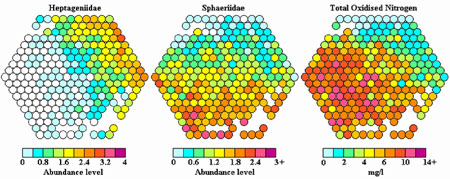
This issue in pdf Subscription Archive: Next issue: July 2005 |
|
||||
Modelling Ecological Health using AI Techniquesby Martin Paysley and Bill Walley The conservation of the natural environment is crucial to our long term survival. Scientists are now turning to artificial intelligence as a basis for better understanding of our surroundings. The Centre for Intelligent Environmental Systems (CIES), Staffordshire University, UK, specialises in the application of artificial intelligence (AI) to problems affecting the natural environment. Projects to date have concentrated on the development of intelligent systems for the biological monitoring of river quality, with the Centre's expertise in this field growing out of the pioneering work carried out by Bill Walley and Bert Hawkes in the early 1990s. Biological monitoring of river quality has grown in importance over the past few decades and the approach now underpins legislation recently introduced in the EU, the Water Framework Directive (WFD). According to the WFD all freshwater bodies should be classified in terms of their ecology, with the target of reaching at least 'good' ecological status by 2015. The objective for CIES in the last few years has been to develop robust models for the interpretation of biological and environmental variables in terms of water chemistry and vice versa. Diagnosis is a key function; that is, determining likely pressures such as organic pollution, excess nutrients or acidity, from biological and environmental data. Prediction is also required; that is, forecasting the biological response to changes in pressures, perhaps as a result of modifications to land use or the treatment of waste water. Both of these functions are of fundamental importance for meeting the requirements of the WFD. The methods used by CIES stem from the belief that experts use two complementary mental processes when diagnosis or prediction is required, namely probabilistic reasoning based upon their scientific knowledge; and pattern recognition based upon their experience of previous cases. Consequently, the group has followed two lines of AI research in parallel - probabilistic reasoning based on Bayesian methods and pattern recognition based on neural networks and information theory. The robust and holistic nature of Bayesian belief networks (BBNs) makes them well-suited to modelling complex systems, like river ecology, where the interaction between the elements is probabilistic in nature. This uncertainty is represented explicitly in the model by probability distributions that encode cause-effect relationships. CIES has used BBN technology to develop, in collaboration with the Environment Agency for England and Wales, a model of river ecology called RPBBN (River Pollution Bayesian Belief Network). The strength of this approach has been that the model can be used to diagnose the pressures that affect a site and/or predict the ecological changes resulting from a programme of remedial measures. The group has also developed its own pattern recognition system, MIR-Max (Mutual Information and Regression Maximisation), based upon information theory. This is now central to its pattern recognition systems and forms the basis of an application called RPDS (River Pollution Diagnostic System) that was developed for the Environment Agency. RPDS uses MIR-Max to categorises n-dimensional biological and environmental data into 'clusters' so that each cluster contains data samples that are similar. The clusters are then ordered in a two-dimensional hexagonal output 'map' so that similar clusters are close together. Since each cluster represents a particular set of biological and environmental variables, and a set of associated chemical variables, the map provides a powerful diagnostic system and data visualisation tool for examining patterns and relationships in the data (see Figure).
The current work of the group is focussed on integrating the BBN and pattern recognition approaches into a single system. This system, due for completion in 2007, will offer enhanced capacity for diagnosis, prediction and classification, and will provide decision support for those responsible for river management in England, Wales and Scotland. Although bio-monitoring remains the principal application domain, the work of the group has diversified into other environmental applications such as oil-spills on inland waters. The Oil Pollution Diagnostic System (OPDS) is a prototype computerised diagnostic tool designed to help the Environment Agency to determine the type of oil product involved, then to 'fingerprint' it to identify its source and to provide solid evidence for legal proceedings against the polluter. This is based on detailed matching of patterns in the gas chromatograms of the pollutant and the original product, after allowing for the effects of weathering. The pattern matching techniques of the OPDS can assist scientists in cases where the chromatograms are particularly complex and matches are hard to achieve. Link: Please contact: David Trigg Rob Buxton Bill Walley Centre for Intelligent Environmental Systems, Staffordshire University, UK |
||||


